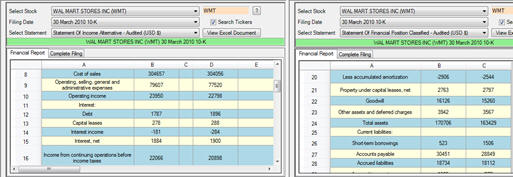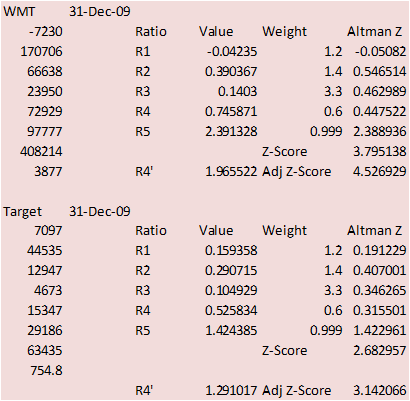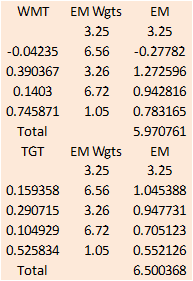5.18 Example:
Wal-Mart versus Target
First, construct the
ratios from the 10-K reports (Consolidated Balance Sheet for R1,
R2, R4) and Consolidated Income Statement/Balance sheet for R3 &
R5.
Wal-Mart:
In Valuation Tutor you can bring up the 30th
March 2010 10-K and set up the Income Statement and Balance
Sheet as described in section 5.2.
These statements contain the raw data for the following
example:

Net Working Capital
= (Current Assets - Current Liabilities) = 48331 – 55561
Total Assets =
170,706
Retained Earnings =
66,638
EBIT = 23950
Shareholders’
Equity = 72,929
Total Liabilities =
97,777
Sales = 408,214
Weighted-average
number of shares Diluted = 3,877

In the above the Adjusted
Z-Score more appropriately uses the current market value in lieu
of Shareholders’ Equity.
Neither WMT or TGT are
judged as being distressed using Altman’s Z-score.
Alternative Version of the Altman Z-score:
EM Model
An alternative form of the Altman model has been constructed
(Altman, Hartzell and Peck (1995)) referred to as the EM-score
(emerging markets) model.
This is
defined as:
EM
Score = 3.25 + 6.56(X1) + 3.26(X2) + 6.72(X3) + 1.05(X4)
Where:
X1 =
Working Capital/Total Assets = (Current Assets - Current
Liabilities)/TA
X2 =
Retained Earnings/Total Assets
X3 =
EBIT/Total
X4 =
Book Value or Market Value of of Equity divided by Total
Liabilities
This model has been used to estimate bond ratings for a firm’s
debt. The following
table provides the estimates:
|
|
|
|
|
|
Rating
|
EM Score
|
Rating
|
EM Score |
|
AAA |
8.15 |
BB+ |
5.25 |
|
AA+ |
7.60 |
BB |
4.95 |
|
AA |
7.30 |
BB- |
4.75 |
|
AA- |
7.00 |
B+ |
4.50 |
|
A+ |
6.85 |
B |
4.15 |
|
A |
6.65 |
B- |
3.75 |
|
A- |
6.40 |
CCC+ |
3.20 |
|
BBB+ |
6.25 |
CCC |
2.50 |
|
BBB |
5.85 |
CCC- |
1.75 |
|
BBB- |
5.65 |
D |
0.00 |
The extended model uses
R1-R4 above plus an intercept term.
For Wal-Mart and Target this is:

Target’s implied bond
rating from the EM model is slightly lower than current bond
ratings (A to A+). Valuation Tutor by allowing you to work with
averages for Industry, SIC or user defined benchmarks, provides
a powerful tool for analyzing and predicting and understanding
bond ratings.
Now that you understand
how to work with this assessment you can use the Valuation Tutor
calculator as the following P&G Reconciliation illustrates:
